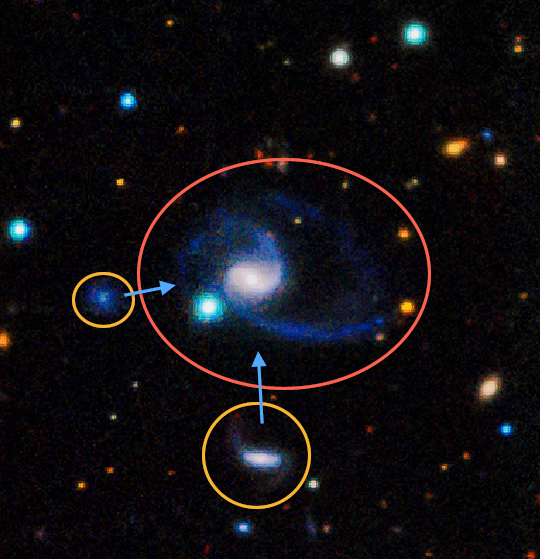This image shows one of the two ‘exact matches’ to the Milky Way system found in a new survey. The larger galaxy, denoted GAMA202627, which is similar to the Milky Way clearly has two large companions off to the bottom left of the image. InImage Credit: Dr Aaron Robotham, ICRAR/St Andrews using GAMA data.
Here’s something astronomers haven’t seen before: galaxies that look just like our own Milky Way. It’s not that our spiral-armed galaxy is rare but instead the whole neighborhood in which we reside seems to be unusual. Until now, a galaxy paired with close companions like the Magellanic Clouds has not been found elsewhere. But using data from a new radio astronomy survey, astronomers found two Milky Way look-alikes and several others that were similar.
“We’ve never found another galaxy system like the Milky Way before, which is not surprising considering how hard they are to spot!” said Dr. Aaron Robotham with the International Centre for Radio Astronomy Research (ICRAR). “It’s only recently become possible to do the type of analysis that lets us find similar groups.”
“Everything had to come together at once,” Robotham added. “We needed telescopes good enough to detect not just galaxies but their faint companions, we needed to look at large sections of the sky, and most of all we needed to make sure no galaxies were missed in the survey.”
Robotham presented his new findings at the International Astronomical Union General Assembly in Beijing this week.
Using what astronomer consider the most detailed map of the local Universe yet — the Galaxy and Mass Assembly survey (GAMA) — Robotham and his colleagues found that although companions like the Magellanic Clouds are rare, when they are found they’re usually near a galaxy very like the Milky Way, meaning we’re in just the right place at the right time to have such a great view in our night sky.
“The galaxy we live in is perfectly typical, but the nearby Magellenic Clouds are a rare, and possibly short-lived, occurrence. We should enjoy them whilst we can, they’ll only be around for a few billion more years,” said Robotham.
Astronomers have used computer simulations of how galaxies form and they don’t produce many examples similar to the Milky Way and its surroundings, so they have predicted them to be quite a rare occurrence. Astronomers they really haven’t been able to tell just how rare they are, until now, using the new survey which looks at hundreds of thousands of galaxies.
“We found about 3% of galaxies similar to the Milky Way have companion galaxies like the Magellanic Clouds, which is very rare indeed,” Robotham said. “In total we found 14 galaxy systems that are similar to ours, with two of those being an almost exact match.”
The Milky Way is locked in a complex cosmic dance with its close companions the Large and Small Magellanic Clouds, which are clearly visible in the southern hemisphere night sky. Many galaxies have smaller galaxies in orbit around them, but few have two that are as large as the Magellanic Clouds.
Robotham and his team will continue searching for more Milky Way twin systems.
The paper “Galaxy and Mass Assembly (GAMA): In search of Milky-Way Magellanic Cloud Analogues” can be read here or (free version) at arXiv
Source: ICRAR


Exact Matches? Yeah right. Just a few years ago, scientists were changing their minds about what they assumed the shape of the Milky Way was. If they arent sure about that, then they cant be sure about how it compares to others.
Exactly, by the ability to make revisions science progresses. Now we know this, so we can move on to the next observation. This is the strength of science, if we couldn’t test and revise we would never get anywhere.
Actually, this observation isn’t surprising. The first equivalent MC satellites were reported just a while back. It was the juxtaposition that was new.
Also, our next door neighbor, the Andromeda galaxy, has satellite galaxies-M32 and M110. I’m not sure I understand why that doesn’t count. The impression that I get from the article is that it’s only a matter of size? The Magellanic Clouds are just bigger than most others?
Andromeda is a “normal” spiral, while we are (supposed to be) a barred spiral. That’s what makes the difference.
Are we sure we arent just looking at ourselfs? Wouldnt THAT be awesome??